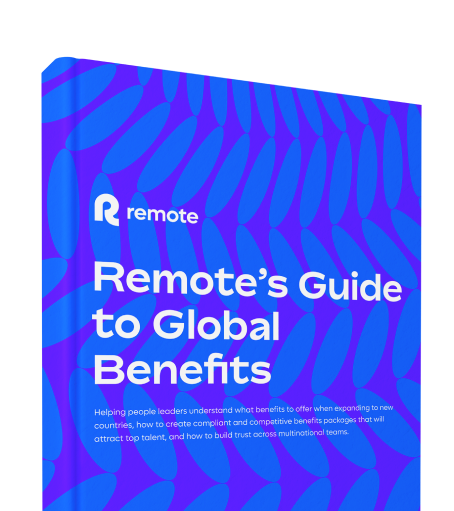
Product Updates — 7 min

Benefits & Leave — 11 min
Since the pandemic, one of the most significant changes we’ve seen is the shift toward distributed teams and global hiring. Companies have realized there are huge advantages to hiring from a borderless talent pool.
Unfortunately, the knowledge and resources necessary to craft benefits packages for international talent haven’t kept up with the speed of hiring in most organizations.
With your company expanding across the world, you need a modern benefits stack fit for a global team. And that’s what we’re covering in this article.
At Remote, we’re obsessed with crafting the best possible employee experience for our team, which spans hundreds of employees across dozens of countries. Keep reading to learn about the key components of modern employee benefits based on our years of experience and expertise in this area.
For companies hiring only in local markets, the conversation around benefits hasn’t changed much in recent years. But for many modern companies, which are increasingly distributed, the need for better benefits to attract and retain top talent has grown.
Until recently, many organizations offered:
Basic statutory and supplemental benefits for their local team members
minimum statutory benefits required for compliance in other countries
Often, this is because they don’t have the right knowledge or resources to do more. However, that strategy creates two classes of employees, harming cohesion in the process.
Teams like Remote have been leading the way in practicing “fair equity,” which means making sure employees in every country have not only the statutory but also the supplemental benefits they need to thrive personally and professionally.
Remote's global HR experts share practical advice for building a locally relevant and globally compliant benefits program to help you attract and keep the world's best talent.

To practice fair equity in your organization, start by understanding what benefits are important in the countries where you’re hiring. Your employees in Brazil or Germany may have different needs than your employees in the United States, depending on what social services may or may not be available.
Then, ask your individual employees what their needs are. This could be through ongoing surveys (not just once a year) or one-on-one conversations. The goal should be to discover which benefits you can offer to support everyone within your company, not just those who live in certain countries.
When every team member feels heard, incentivized, and supported, your organization will be able to collectively drive a sustained increase in productivity and employee retention rates.
Once you’ve conducted some internal and external research to understand the needs of your employees, you can start constructing better benefits packages.
A typical benefits stack includes:
Healthcare
Dental and vision care
Pension or 401(k)
But a modern benefits stack should also include:
Flexible work arrangements
Paid leave policies, including parental leave
Mental health and wellness care
Home office allowance
Learning stipends
Travel insurance
Life insurance
Personalized benefits
Career and development opportunities
Let’s drill down into some of these supplemental benefits, including how they can help you attract and retain top talent for your global organization.
In the new age of work, flexibility is one of the most important modern workplace benefits you can offer your employees. In fact, 62% of US workers say that flexibility is a benefit they want to achieve a better work-life balance.
Flexibility goes beyond simply allowing people to work from home, which is now more of a norm than going to the office each day. Instead, it means that employees don’t necessarily have to work specific hours that suit their organization. They can work at the times that suit their own needs and lifestyles.
Modern organizations should lean into asynchronous, flexible work and away from rigid Monday through Friday, 9-to-5 schedules for all workers. This is not only an incredible benefit but a necessity when you’re working with colleagues across many time zones.
Plus, this level of flexibility opens up your recruitment to a wider pool of international candidates. You can create a diverse, talented team that helps your business grow. Diverse companies earn 2.5x higher cash flow per employee than non-diverse ones.
The need for mental health and wellness benefits is more apparent than ever. Mental health is worsening for 34% of US employees, but only 43% say that their employer provides health insurance with coverage for mental health disorders.
Show your employees that you care about their wellness with flexible work and paid leave policies. Consider what tangible resources you can offer to your team, like local therapy or coaching services.
At Remote, we’ve partnered with Modern Health to offer therapy, coaching, and self-guided mental health resources to our employees in dozens of countries. We also help our customers find the right mental health vendors for their international teams!
If your employees were working alongside you in the office, you’d equip them with a comfortable desk, chair, monitors, and other equipment to optimize their work experience. The need for these supplies doesn’t change just because an employee works from home.
Don’t assume your employees already have everything they need. Our interviews with remote employees showed us that one of the biggest challenges was not having a proper desk, chair, or other equipment.
Consider offering a home office stipend to help employees get the things they need to thrive in their work lives. At Remote, we offer equipment stipends for desks and chairs in addition to equipment like laptops, external monitors, keyboards, mice, and webcams. If an employee requires additional accommodations to work from home due to a disability or health issue, we help them with those needs.
Offering unlimited PTO has become a major point of conversation globally. Many tech companies offer this perk as a way to attract the best.
Studies also show that taking time off is good for employee well-being. Taking leave decreases the likelihood of job stress by 56% and more than doubles the likelihood of employee satisfaction. However, simply offering unlimited PTO is not enough. You have to go a step further and be intentional about the way you structure and communicate your leave policies.
The first step is in understanding what’s required and what the cultural norms are around paid time off in the countries where you’re hiring.
While the US has no federal law requiring that employers give paid time off to their employees, paid leave is available from most employers.
Among private industry workers, 86% of union workers and 77% of nonunion workers are paid sick leave. Paid family leave is also available to almost a quarter of employees, while 92% of union and 79% of nonunion workers have paid vacation days.
In the European Union, employers are required to offer employees at least four weeks of paid leave, and many EU countries require more than the basic four weeks.
Due to these variances, offering a blanket PTO policy may seem like the best option for your global workforce. You still must be intentional with that policy, though, especially when you consider that employees in certain countries may feel uncomfortable asking for time off.
At Remote, we offer employees unlimited PTO with a 20 day minimum each year. Yes, employees must take at least 20 days off, no matter where they live!
This time can be used to travel, spend with family, tend to obligations, or simply rest and recharge. We still encourage people to take more than the minimum, and we make sure employees in countries with higher minimums follow the law.
In addition to PTO, it’s also important to create locally compliant (in all the countries where you’re hiring) and comprehensive parental leave policies. That way, no one in your organization has to stress about managing work and personal finances when deciding to grow their family.
Side note: We can help you ensure you follow local regulations in all the countries you hire in. Speak to one of our friendly experts today!
Also consider paid leave policies for employees who are experiencing traumatic experiences. Policies with mental health in mind are more important than ever, especially as we continue to live through a global pandemic. Bumble is a great example of this, having offered all employees a week off to deal with stress, grief, and burnout during COVID-19.
Technology is advancing constantly (just look at artificial intelligence), providing new and exciting opportunities for benefits administration. But the most exciting opportunity?
Personalizing employee benefits.
With personalized benefits, you can provide your workforce with a core benefits package that suits their needs. Think about childcare benefits. Not every employee needs them, so why not offer those individuals something different instead?
By using the right technology, you can offer personalized benefits based on employee preferences, working hours, salaries, and so on.
Pro tip: Take a look at Remote benefits to see how you can provide country-specific benefits for your international employees!
Personalized benefits are helpful for you, too. Why? Because you can administer them automatically based on employee eligibility, which saves you time and increases accuracy.
For example, certain employees need to work specific hours to qualify for specific benefits. With technology, you can get those employees qualified automatically.
Employees want career progression. In fact, investing in professional training, growth, and development is important to today’s workforce. Studies show that career development increases motivation and that employers are using learning and development as their primary employee retention strategy.
So, how exactly can you offer career progression and upskilling opportunities to a distributed team?
Here are some suggestions:
Provide access to online courses and workshops. Let employees complete their training asynchronously by providing access to online courses. Platforms like Udemy and LinkedIn Learning offer a wide range of courses that teach technical skills, soft skills, and more.
Offer mentorship programs. Give employees one-on-one coaching and development opportunities through mentorship programs. This involves pairing experienced employees with those looking to develop their skills. With remote communication tools, mentors and mentees can meet on a regular basis to discuss skills, progress, and more.
Provide clear pathways for career progression. Create a clear, structured pathway for career development to show employees how they can progress within the company. In the customer service department, for example, the pathway might look as follows: junior customer support representative > customer support representative > senior customer support representative > customer support team leader.
The biggest challenges we see companies encounter when trying to offer modern employee benefits packages are:
Knowledge of local regulations
Internal resources to figure out what people want and need
Cultural fluency
Budget
If you’re a growing business with a tight HR and people budget, you may not be able to go above or beyond statutory benefits for now. Instead, you can offer other modern workplace benefits, like career progression or flexible hours, to keep employees satisfied and motivated in their roles.
However, there’s a huge business case to be made for increasing your budget when possible.
Providing competitive, equitable benefits to a global team is no small task. For Sastrify, managing benefits across multiple countries meant dealing with complex regulations, inconsistent coverage, and administrative headaches.
By switching to Remote, Sastrify unlocked:
✅ Equitable benefits for employees worldwide
✅ Faster, more accurate payroll across multiple locations
✅ A single provider for seamless hiring and compliance
With Remote, Sastrify’s team enjoys the same high-quality benefits — no matter where they live. See how they made it happen below.
Want to offer world-class benefits without the hassle? Let’s talk.
Global hiring can present many challenges, but when every employee feels supported, equal, and welcome, that’s when magic can happen. Remote is an example of this. Our global team helped us achieve a $1B+ valuation in under two years, and our people team works hard to give back and demonstrate that we’re all in this together.
Contact our team to learn more about working with Remote for your global hiring needs. Our hiring experts can help your business offer the best in modern benefits.
Create an account with G2's top-ranked multi-country payroll software and start onboarding your first employees in minutes.

Subscribe to receive the latest
Remote blog posts and updates in your inbox.

Product Updates — 7 min

Global Payroll — 2 min

Minimum Wage & Compensation — 7 min

Newsroom — 5 min